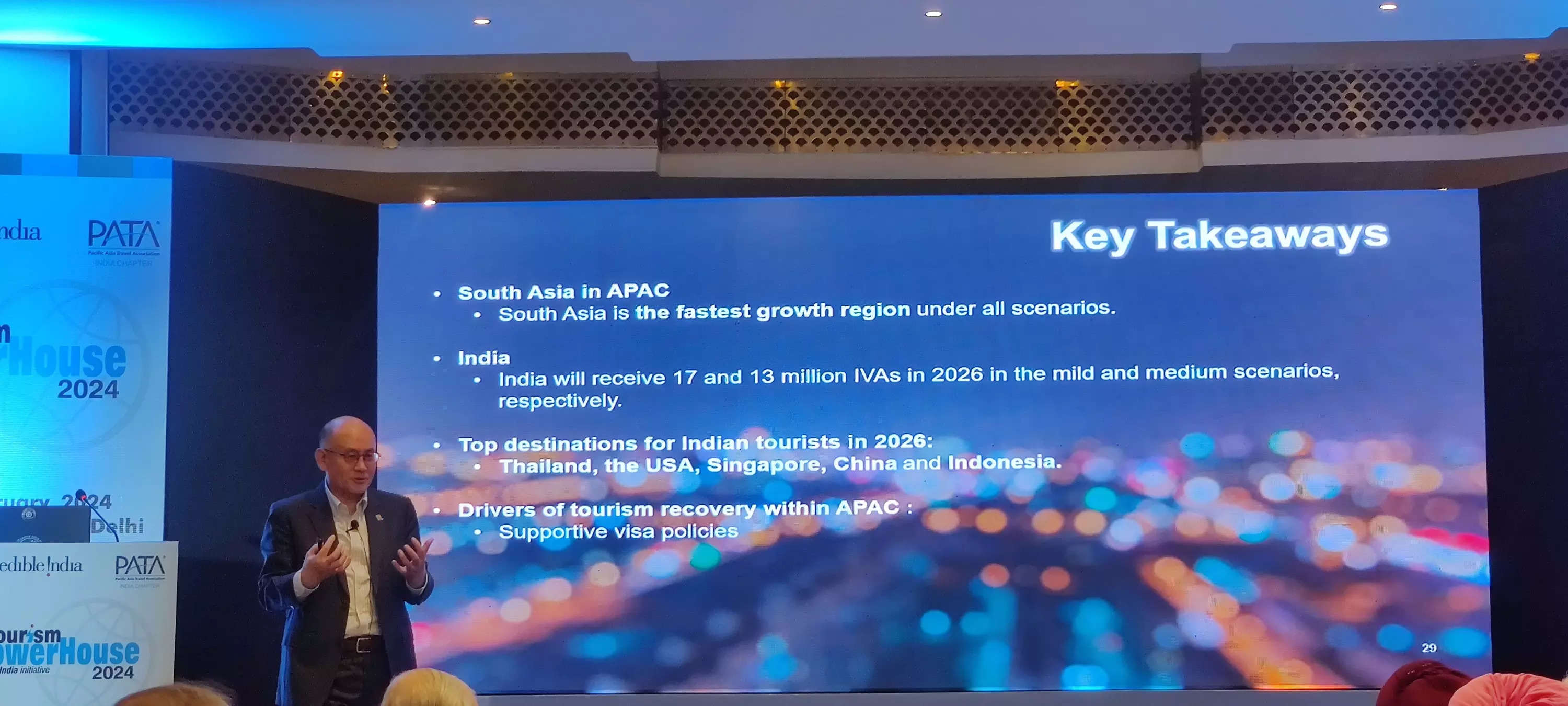[ad_1]

By the end of this year, the tourist arrivals in South Asia are expected to return to the levels seen in 2019, indicating a notably rapid recovery compared to other sub-regions. Additionally, under both mild and severe scenarios, it is projected that by the end of 2024, South Asia will attract 25 million and 60 million visitors, respectively, signifying a substantial influx of tourists to the region. This surge into the region is anticipated to benefit India’s inbound tourism significantly, as per Prof Haiyan Song, Research Head at PATA, and Dean of Hospitality and Tourism at Hong Kong Polytechnic University. The Tourism Forecast and Trends analysis presented by the professor showed that the inbound tourism to India experienced a downturn in 2021 due to various factors. However, it is anticipated to fully rebound and reach pre-pandemic levels by the end of this year, marking 104.2 per cent recovery in the medium scenario. The international visitor arrivals (IVAs) are expected to exceed the pre pandemic level in 2026 by 58.5 per cent and 20.5 per cent in mild and medium scenarios, respectively.
“India has emerged as the fastest recovering destination, exceeding pre-pandemic levels by over 58 per cent by 2026. This robust growth trajectory underscores the positive outlook for India’s tourism sector in the forecast period. Looking ahead, the recovery is anticipated to be driven significantly by initiatives from the supply side, notably the Union Budget 2023, which aimed at enhancing infrastructure. Additionally, the Incredible India branding initiative, including the possible launch of Incredible India 3.0 campaign, is expected to have a substantial impact on supply, attracting tourists from various source markets to India,” he added.
Also, as shared by Song, India will receive 17 and 13 million IVAs in 2026 in the mild and medium scenarios, respectively. Despite currently ranking 16th in international arrivals in the Asia Pacific region, India’s attractiveness to tourists is expected to improve, said Song.
Additionally, India is projected to rise to 14 markets by 2036, driven by faster economic growth, making the country more attractive for both tourists and investors.
China anticipated to emerge as significant source market for India
The major source markets for India currently include Bangladesh, the USA, the UK, with projections indicating significant growth from other markets by 2026, such as Malaysia. Comparing the pre-COVID-19 source market rankings of 2019 with the projections for 2026, there are notable changes, with Australia dropping down the ranks while China and Malaysia ascend.
Song shared that China is anticipated to emerge as a significant source market for India in the coming years, primarily due to the forecasted GDP growth of around five to six per cent per annum as per a report. “Visitor arrivals from China will be 429 thousand by 2026 (126.4 per cent of the 2019 levels under the medium scenario). Severe scenarios will see slower recovery in 2026 (59.7 per cent, given geopolitical and macro-economic concerns. Notably, the simplified visa process would help to attract more Chinese visitors,” shared Song.
Visitor arrivals from Bangladesh to India are also expected to surpass 2019 levels by 111.8 per cent by 2023, with visa-free access likely enhancing this trend. The USA is expected to contribute around 1.7 million visitors to India by the end of June, with American tourists known for their high spending. Factors driving this include the ongoing economic recovery and consumer confidence in the US.
“To further attract tourists from the US and other developed countries, India should focus on promoting diverse tourism products, especially luxury medical tourism, leveraging the comparatively lower costs of medical treatments in India,” suggested Song.
As for visitors from the UK, around 1.1 million arrivals are anticipated by the end of 2026. In the same period, visitor arrivals from Australia will be 407.3 thousand recording an increase of 110.9 per cent of 2019 level. Visitor arrivals from Australia will outperform the 2019 level by 24.9 per cent this year under the mild scenario.
Similarly, Canada IVAs recovery rate will be 138.3 per cent in 2024 and 406.6 thousand visitors from Canada will visit the country by the end of 2026, hitting 115.6 per cent of 2019 level. Malaysia, another strong market for India, will see high recovery rates in the mild scenario, shared Song, adding that about 483.7 thousand visitors from Malaysia will be recorded by the end of 2026.
Indonesia and Canada predicted to become more popular
On the outbound front, the market of India is generally stable during the forecast period as per Song. Sharing further, he stated that the top destinations for Indian tourists in 2026 include Thailand, the USA, Singapore, China and Indonesia. Out of these, Indonesia and Canada are predicted to become more popular, with their rankings increased by 1 and 3 places from 2019 to 2026, respectively. Speaking about India’s tourism potential, Song shared that India is known by its geographical diversity and rich cultural heritage, which also emerged as a focal point of the research done for PATA. Despite this inherent allure, global awareness of India’s cultural depth remains uneven across key source markets, presenting untapped opportunities for targeted promotion and marketing initiatives.
Song also advocated for proactive measures and strategic investments, deeming them essential for India to capitalise on its tourism potential and emerge as a premier global destination in both traditional and new markets.
South Asia poised to experience the swiftest recovery among sub-regions
The presentation made by Song also highlighted the rapid recovery of South Asia, with the region leading in impact on the tourism economy. The recovery rates in South Asia outpaced those of Southeast Asia and the Asia Pacific region as a whole as per the tourism monitoring report. Looking ahead to 2026, South Asia is poised to experience the swiftest recovery among sub-regions, with a projected growth rate of 1.2 per cent, shared Song.
“By the conclusion of this year, tourist arrivals in South Asia are expected to return to the levels seen in 2019, indicating a notably rapid recovery compared to other sub-regions. Additionally, under both mild and severe scenarios, it is projected that by the end of 2024, South Asia will attract 25 million and 60 million visitors, respectively, signifying a substantial influx of tourists to the region,” he shared.
A closer look at sub-regions revealed intriguing dynamics. Northeast Asia held the highest market share in 2019, while South Asia, including India, accounted for a relatively small share. However, projections indicated a significant increase in South Asia’s market share by 2026, primarily fueled by a surge in arrivals to India.
After Covid-19, economic growth in many major source markets in the Asia Pacific region has been severely impacted, recalled Song. Consequently, the number of tourists traveling from Europe to India and other parts of Asia Pacific has been limited. Factors such as high inflation in Europe and the United States have led to significantly increased travel costs, sometimes double or even triple the pre-pandemic levels, deterring international travel. Song said that these economic challenges have played a significant role in dampening international tourism demand.
To this, Song emphasised the critical role of various factors such as economic conditions, digital transformation, consumer confidence, and supply chain resilience in driving future tourism recovery. Additionally, supportive visa policies will remain a critical driver for the tourism recovery within the APAC region, which is expected to see total arrivals going up to 133.35 per cent in a mild scenario by 2026.
[ad_2]
Source link



